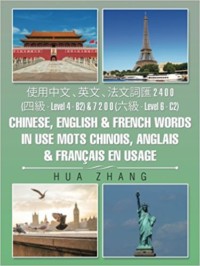Title: 使用中文、英文、法文詞匯2400(四級-Level4-B2)&7200(六級- Level 6 – C2) Chinese, English & French words in use Mots chinois, anglais & français en usage
Author: Hua Zhang
Publisher: AuthorHouse
ISBN: 9781524668365
Pages: 350
Genre: Education/ Language Arts & Disciplines
Reviewed by: Barbara Bamberger Scott
Pacific Book Review
A Chinese professor has compiled an extensive study guide in three languages, especially helpful in aiding Chinese students to speak both English and French idiomatically, titled Chinese, English & French words in use Mots chinois, anglais & français en usage.
Author Hua Zhang has a foreign language degree from the Beijing Foreign Language Study University, and has studied and taught in France, at the Berlitz School and the CPLE—Cours Pratique des Langues Ètrangerès. The book is intended for those needing levels 2, 4 and 6 vocabularies. The exercises can be utilized by native speakers of any of the three languages. The author notes that many Chinese people need to learn French, but have already studied English before they embark on the third language. Thus two languages can inform one’s understanding of the third.
As Hua Zhang points out, it is not difficult to know the proper use of a single word, but it is much harder to know how to use a word in various contexts. Thus his lexicon is based on the following method: he begins with a single word in Chinese (both characters and Anglicized spelling), follows it with a sentence expressing that word in English and then in French. He believes that by starting with the single word, the sentence will be easily mastered, as he claims will accelerate your advancement greatly.
The main body of the book comprises 350 pages and is followed by a Chinese index and a list of reference books. Being geared to the Chinese learner, it begins with the most used monosyllabic words, then the most used Chinese characters, then the most used disyllabic words in the press. An example would be the Chinese word (in English characters) chēnghào, translated into the English as, “He has a title of nobility,” and into French as, “Il a un titre de noblesse.” The Chinese word fànwéi is rendered into English as “It is beyond the scope of his study,” and, in French, “Cele dépasse le cadre de cette étude.” The value to students of all three languages is obvious, though it was composed mainly for the benefit of Chinese speakers learning the other languages. An English speaking person wanting to learn phrases in French, for example, can learn that “Let’s share my joy!” translates to the French, “Que tout le monde partage ma joie!”
Many students speaking either English or French, wishing to travel or work in China, could use this book as a guide to common symbols, although this would be more complicated in practice than the memorization of the more recognizable Latin-based vocabularies and common alphabet. Designed for serious self-study, Hua Zhang’s compendium would undoubtedly be useful for those seeking proficiency in one or all of the three languages presented.



Follow Us